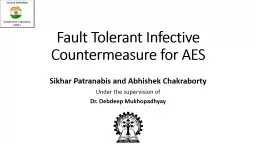

AES Sikhar Patranabis and Abhishek Chakraborty Under the supervision of Dr Debdeep Mukhopadhyay Secured Embedded Architecture Laboratory SEAL Outline Introduction Differential Fault Analysis DFA ID: 317082
Download Presentation The PPT/PDF document "Fault Tolerant Infective Countermeasure ..." is the property of its rightful owner. Permission is granted to download and print the materials on this web site for personal, non-commercial use only, and to display it on your personal computer provided you do not modify the materials and that you retain all copyright notices contained in the materials. By downloading content from our website, you accept the terms of this agreement.
Slide1
Fault Tolerant Infective Countermeasure for AES
Sikhar Patranabis and Abhishek ChakrabortyUnder the supervision ofDr. Debdeep Mukhopadhyay
Secured Embedded
Architecture Laboratory (SEAL)Slide2
OutlineIntroductionDifferential Fault Analysis (DFA)
Countermeasures to DFA – Detection vs InfectionInfective Countermeasures – Formal Proofs of SecurityInfective Countermeasures - LoopholesFault Tolerant Implementation of Infective CountermeasuresConclusionsSlide3
Introduction : Fault Analysis and CountermeasuresSlide4
Fault Attacks : A Brief Overview
Introduction of faults in the normal execution of cryptographic algorithms and analysis of faulty output to obtain the keyFirst conceived in 1996 by Boneh
, Demillo
and Lipton E. Biham developed Differential Fault Analysis (DFA) of DESToday there are numerous examples of fault analysis of block ciphers such as AES under a variety of fault models and fault injection techniquesPopular Fault Injection Techniques – Clock Glitches, Voltage Glitches, EM and Optical Injection TechniquesSlide5
Differential Fault Analysis (DFA)Comparison of fault-free and faulty ciphertexts
Important factors are fault location and fault modelFault Location:Data PathKey ScheduleFault Model:Bit Faults
Byte FaultsSlide6
DFA of AES: State of the ArtSlide7
Countering DFASlide8
Detection Based CountermeasuresAlso known as Concurrent Error Detection (CED) techniques
Use various kinds of redundancy to detect faultsVulnerable to attacks in the comparison step itselfVulnerable to biased fault attacksSlide9
The Basic Principle of CEDsSlide10
Examples of CED
Information Redundancy – Robust Codes
Time Redundancy
Hardware Redundancy
Hybrid Redundancy - REPO
Source :
Guo
et. al. , Security analysis of concurrent error detection against differential fault analysis – Journal of Cryptographic Engineering, 2014Slide11
Infective Countermeasures
The main initial idea behind infective countermeasures was to diffuse the impact of the fault such that even if the adversary were to attack the comparison step, the state would still be affectedSlide12
The Infection Mechanism
Source : Lomne et. al. , On the Need of Randomness in Fault attack Countermeasures – Application to AES, FDTC 2012Slide13
Infective Countermeasures : State of the ArtSlide14
CHES 2014 Infective CountermeasureSlide15
CHES 2014 Countermeasure (Contd.)
Correct Computation
Faulty ComputationSlide16
Unexplored Territory-1Formal
Proof of SecurityA frequent criticism of infective countermeasures - no explicit formal proof of security
Slide17
Unexplored Territory-||
The countermeasure provides security against fault attacks that target the state registersWhat about faults that target the execution order of instructions instead?For instance instruction skip attacksSlide18
Single Fault InjectionInfection upon detection of fault destroys any correlation between output differential ∆ and key K
Hence ∆ and K are independent
Information Theoretic
Proof of SecuritySlide19
Security Proofs (contd.)Multiple Fault Injection
The adversary must introduce the same fault in a redundant-cipher round pairNot easy due to the presence of random intermediate dummy rounds in between
The Attack Probability for 30 Dummy
Rounds Slide20
Security Proofs (contd.)The Evaluation
We focus on the event e’ where an adversary introduces the same fault in a redundant-cipher round pair
Set of faults possible for key
Slide21
The Instruction Skip Fault ModelThe
adversary can skip an instruction Equivalent to replacing instruction by a NOPPractically achievable on a variety of architectures8-bit AVR microcontrollers32-bit ARM9 processor32-bit ARM Cortex-M3 processorVariety of injection techniques possible - Clock glitches, EM Glitches, Voltage glitches and Laser shotsSlide22
The Attack Idea
What if the adversary skips this step??Slide23
The Attack Procedure
Replaced by a Redundant RoundSlide24
The Information LeakageConsider the event e
that the attacker successfully performs the instruction skip to recover the keySlide25
The Loop HolesSlide26
Modified Infective CountermeasureSlide27
Instruction Skips on the Modified CountermeasureMust skip two instructions now – the round counter increment as well as the masking steps in two separate rounds
Practically feasible second order fault attack?Slide28
Some ComparisonsSlide29
But what about other Instruction Skip instances ??Slide30
Fault Tolerance at the Instruction LevelInjection of faults in two instructions separated by only a few clock cycles is difficult to achieve in practice
Rewrite compiler generated assembly code by replacing each instruction by a sequence of one or more idempotent instructionsAll instructions belong to the x86 instruction set and have uniform size of 32 bitsProvides protection against instruction skip attacks in generalSlide31
Sample Instruction Replacement SequencesSlide32
Sample Instruction Replacement SequencesSlide33
Impact on Code SizeSlide34
Simulation StudiesSlide35
Experimental Set-UpSlide36
Experimental ResultsSlide37
ConclusionsInfective
countermeasures thwart DFA using single and double fault injections that do not alter the flow sequenceInfective countermeasures are vulnerable to instruction skip attacks unless properly implementedFault tolerance can be achieved at the instruction level using idempotent instructionsSlide38
DisseminationsS.Patranabis, A.Chakraborty
and D.Mukhopadhyay. Fault Tolerant Infective Countermeasure for AES. In Security, Privacy, and Applied Cryptographic Engineering (SPACE) 2015Slide39
Thank You for your attention!!